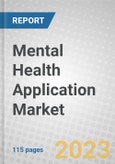The report covers mental health app industries, initiatives, patents and companies. It reviews the importance of mental health apps, the app development process and the regulatory settings. It then discusses some of the investments and clinical trials of mental health apps. The main forces that drive the market are also discussed.
The report examines the market by product type, age basis, technology basis, technique basis and region. Product type includes self-help apps, and disorder apps. Self-help apps are further categorized into meditation and mindfulness, journaling and others.
The specific regional markets discussed are North America, Europe, Asia-Pacific, and the Rest of the World (RoW).
The report also summarizes the main industry acquisitions and strategic alliances from January 2020 through December 2022, and the trends it sees in this activity.
Report Includes
- 20 data tables and 19 additional tables
- An overview of the global market for mental health applications
- Analyses of global market trends, with historical market revenue data (sales figures) from 2020 to 2022, estimates for 2023, and projections of compound annual growth rates (CAGRs) through 2028
- Estimate of the actual market size and revenue forecast for the mental health apps market in USD millions, and corresponding market share analysis based on product type, age group, app store, therapy technique, and region
- Classifications and comparisons of the types of mental health apps, as well as their advantages and disadvantages
- Insights into the current technologies as well as the effects new technologies will have on the market
- Identification of challenges and discussion on how to overcome them to reach the market’s commercialization potential, as well as analysis of clinical trials and ESG trends
- Information on recent mergers and acquisitions (M&A), collaborations, agreements, partnerships, product launches, relevant patents
- Profiles of the major companies
Table of Contents
Executive Summary
Over the last decade, there has been a growing prevalence of mental health disorders across the globe, a good part of which was due to the COVID pandemic. Not only was the pandemic responsible for many new cases of mental health disorders, it worsened the condition of many people who were already suffering from mental health disorders and, due to lockdowns, made treatments less accessible.
Mental health apps started proliferating during the COVID pandemic. Mental health apps are mobile applications that can alleviate mental health disorders. Currently there are more than 20,000 mental health disorder apps available in the iOS and Google app stores.
Even after the pandemic, there are other factors driving the market for mental health apps. The limited number of psychiatrists, psychologists and other professionals available for treating mental health disorders is a major factor. Additionally, the advantages of the mental health apps, such as accessibility, affordability and anonymity, are also boosting the market growth. The demand for mental health apps have also generated the interest of venture capitalists and as a result there has been a sharp increase in funding for mental health apps.
The mental health apps market also faces certain challenges, such as concerns about data security and safety. There have been incidences of data theft. There is also a challenge of customer retention, as most customers stop using the apps within a week after downloading. Finally, the effectiveness of the apps is still questionable.
Companies Mentioned
- Calm Inc.
- Cerebral Inc.
- Headspace Inc.
- K Health Inc.
- Mood Mission
- Moodtools
- Real
- Resiliens Inc.
- Sanvello Health Inc.
- Talkspace Inc.
- Teladoc Health Inc.
- Twill Inc.
- U.S. Department of Veterans Affairs (Va)
- Woebot Health
- Wysa Ltd.
- Youper Inc.
Table Information
| Report Attribute | Details |
|---|---|
| No. of Pages | 115 |
| Published | September 2023 |
| Forecast Period | 2023 - 2028 |
| Estimated Market Value ( USD | $ 3 Billion |
| Forecasted Market Value ( USD | $ 6.5 Billion |
| Compound Annual Growth Rate | 16.6% |
| Regions Covered | Global |
| No. of Companies Mentioned | 16 |









